LEE PRICE | Cake
Opening, 5pm - 7pm Friday, April 25 - May 24, 2025
In Cake, Lee Price masterfully transforms an everyday indulgence into a poignant meditation on time, memory, and the emotional complexities that accompany celebration. With her signature photorealistic style, Price presents exquisitely detailed paintings of cakes—decadent, colorful, and visually inviting—only to reveal a deeper undercurrent of nostalgia and melancholy. Each scene, rich with vibrant hues and intricate patterns, captures a moment just after the gathering has ended, the remnants of an event lingering like echoes of the past. Through these compositions, Price invites viewers to consider the transient nature of joy, the rituals we build around food, and the quiet spaces left behind when the party is over. Cake is a feast for the eyes but, more profoundly, an exploration of the fleeting nature of time and the personal histories we attach to the simplest of confections.
View work in the exhibition ►
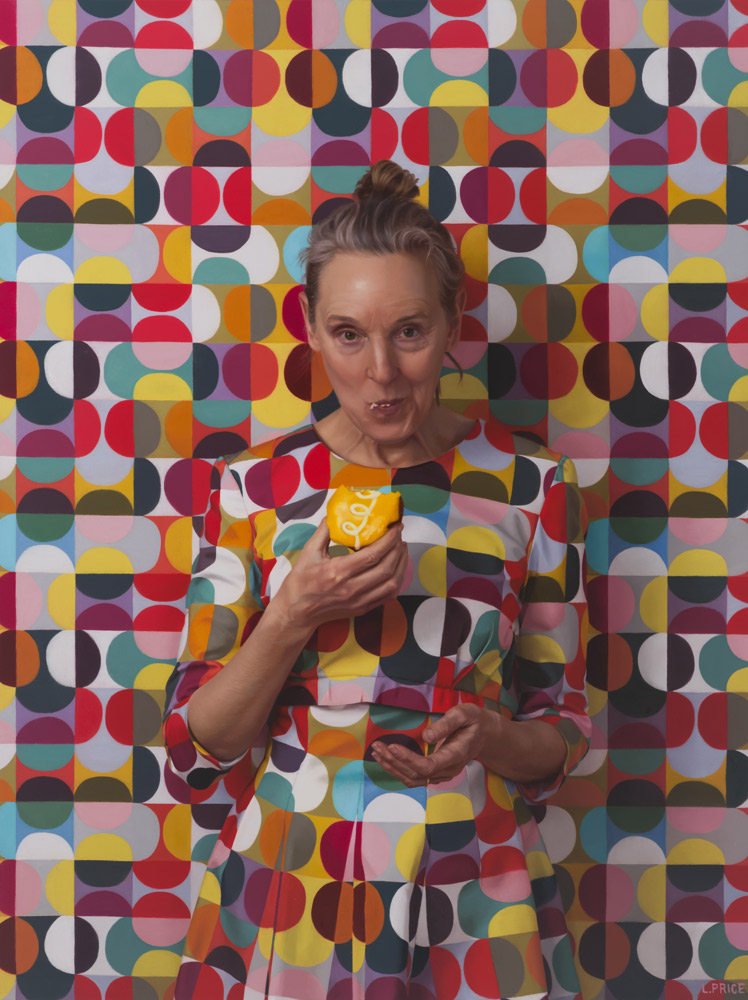
EVOKATION | art + culture + inspiration | July 2024 issue
Be aware in the present. Notice the magic and beauty of the moment. These are Jeremy Miranda’s painting mantras. Miranda finds in daily life unlimited inspiration for his paintings. The works he exhibits in Evoke’s Summer Salon are interior environments and exterior scenes close to home.
“I’m finding beauty in everything,” says Miranda, whose latest pieces include images of a pot of boiling water and a simple wooden table with two chairs. Miranda never travels far from home to find his subjects. Instead, he portrays interior and exterior scenes within a five-mile radius of his studio. “I couldn’t paint a place I visit,” he says. “I need to feel a connection to a place. When I do, I start to see the whole universe there. Then I can drift into a kind of cosmic existence when I paint.”
Other artists in the Summer Salon Part lI exhibit include David T. Alexander, Christopher Benson, Lynn Boggess, Esha Chiocchio, Jeremy Mann, Javier Marín, Louisa McElwain, Soey Milk, Kristine Poole, Lee Price, Michael Scott, Andrew Shears, Thomas Vigil, and Aron Wiesenfeld.
read past issues ►
Gallery Info
Founded in Santa Fe, NM in 2009, EVOKE Contemporary remains committed to providing a dynamic platform for exploring bold and thought-provoking contemporary art. The gallery is dedicated to fostering the careers of artists who embody authenticity, mastery, and vision, while nurturing works of profound depth and context. EVOKE Contemporary champions a diverse array of voices and artistic disciplines, representing artists whose work delves into the human condition, explores complex social values, and celebrates the beauty of nature and the human form.
EVOKE Contemporary is centrally located in the Railyard Arts District of Santa Fe along with the New Mexico Museum of Art Vladem Contemporary, and SITE Santa Fe, a contemporary art space, and seven additional contemporary art galleries. The Railyard district, a short walk from the historic Plaza, offers a Farmers Market, the Railyard Park, and an array of shopping, dining and, entertainment opportunities.
Gallery hours are: Tuesday through Saturday, 10 - 5.
You may reach us via Email and 505.995.9902 telephone messaging daily 10 - 5.
Thank you for your continued support.

LOOKING & SEEING
contemplations on a theme
Today's theme is the color blue.
John O'Hern is an arts writer, curator and retired museum director who has been providing a biweekly contemplation of a single work of art from our gallery. He is continuing his series of contemplations of various themes inspired by our gallery artists. In our fast-paced lives overflowing with information, we find it necessary and satisfying to slow down and take time to look. We hope you enjoy this perspective from John.
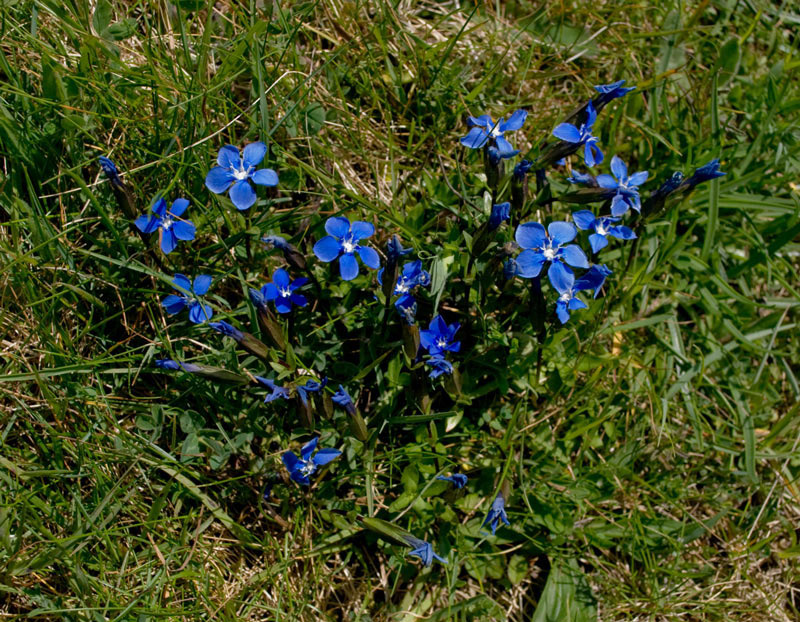 On the first morning of the first day of my first trip to Ireland I went on a wildflower walk in the Burren in County Clare with a group of botanists and nature enthusiasts. One of the botanical curiosities of the Burren is that Mediterranean and Alpine wildflowers bloom together in the rocky terrain. I was looking for spring gentian which I mistakenly thought was the only true blue in nature. It isn’t. We saw one tiny plant on our walk.
On the first morning of the first day of my first trip to Ireland I went on a wildflower walk in the Burren in County Clare with a group of botanists and nature enthusiasts. One of the botanical curiosities of the Burren is that Mediterranean and Alpine wildflowers bloom together in the rocky terrain. I was looking for spring gentian which I mistakenly thought was the only true blue in nature. It isn’t. We saw one tiny plant on our walk.
The next day as I walked up a road past the grave of John O’Donahue, the poet, author, former priest and philosopher, I saw a group of people gathered at the side of the road. When I reached them, I saw they had found a large patch of spring gentian, one of them in the shape of a heart.
Among the songs that often sail through my head, and sometimes get stuck, is “Am I Blue?” I’m not sure if its Billie Holiday, Ray Charles or me singing, but it’s there. I’m seldom blue in the sense of The Blues, the musical form that came out of the African-American community in the deep south in the 1860s. The Blues is cathartic, though, when I am. B.B. King wrote, “Blues is a tonic for whatever ails you. I could play the blues and then not be blue anymore.”
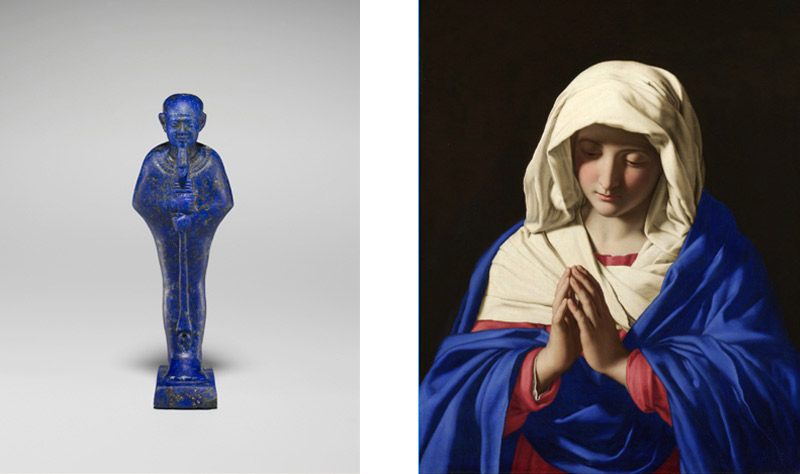 I’ve been thinking about blue in art and the wonderful deep blue of lapis lazuli mined in what is now Afghanistan. The name comes from the Latin words “lapis”(stone) and “lazuli” which is derived from the Persian word for “blue” or “of the heavens--so, “stone of the heavens”.
I’ve been thinking about blue in art and the wonderful deep blue of lapis lazuli mined in what is now Afghanistan. The name comes from the Latin words “lapis”(stone) and “lazuli” which is derived from the Persian word for “blue” or “of the heavens--so, “stone of the heavens”.
The ancient Egyptians used lapis for the eyebrows and eye surrounds on the golden death mask of Tutankhamun. They also carved the stone as in the tiny Cult Image of the God Ptah now at The Met.
Later, lapis lazuli was ground into a powder and mixed with melted wax, oils, and pine resin and rinsed with other materials to create Ultramarine referring to its coming from “beyond the sea”. The material was rare and the process was time consuming and expensive. Michelangelo couldn’t afford it and Vermeer went into debt using it in his paintings.
Ultramarine was usually reserved for paintings of the blue mantle of the Virgin Mary. A spectacular example is The Virgin in Prayer, ca. 1654 by Giovanni Sassoferrato.
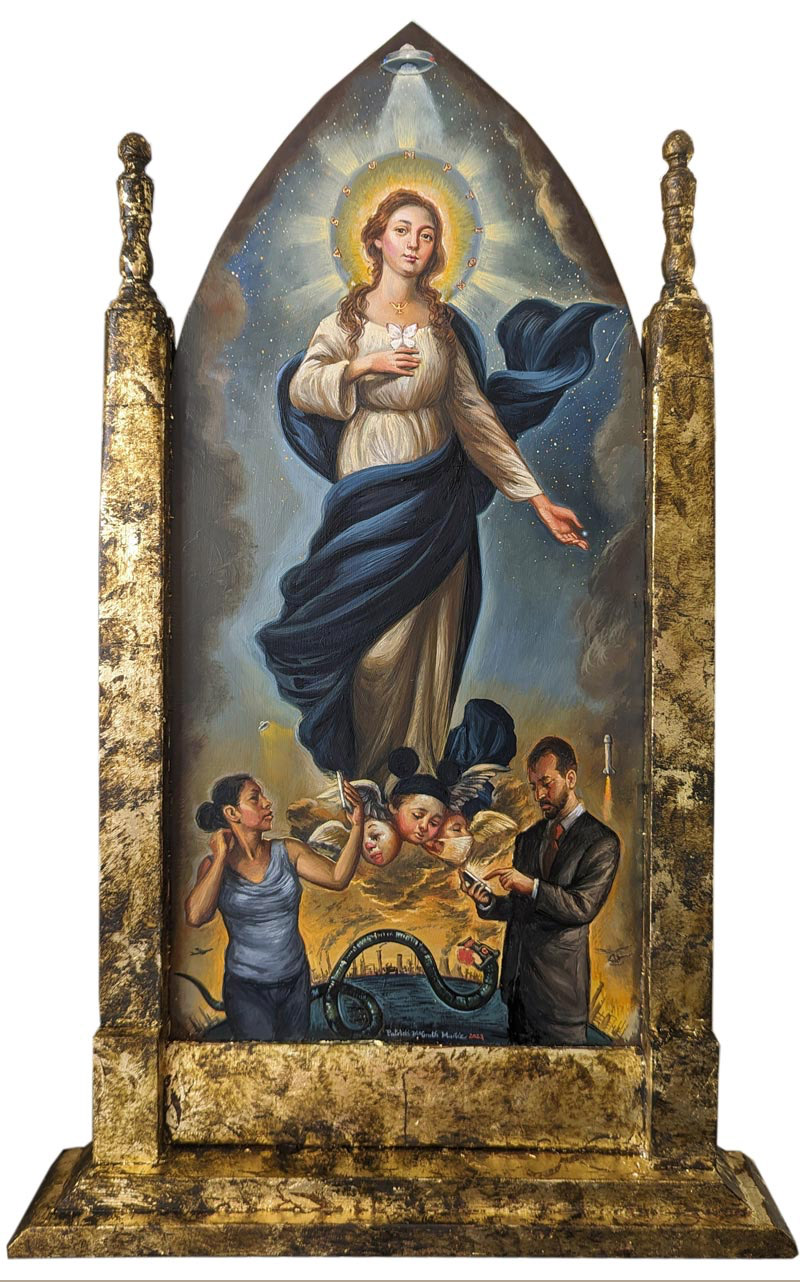 Patrick McGrath Muñíz painted his symbolically rich The Pale Blue Dot with the Virgin Mary draped in a deep blue mantle and about to hold Earth, a “pale blue dot” in her left hand. (For Patrick’s narrative on the painting, visit the Evoke website.)
Patrick McGrath Muñíz painted his symbolically rich The Pale Blue Dot with the Virgin Mary draped in a deep blue mantle and about to hold Earth, a “pale blue dot” in her left hand. (For Patrick’s narrative on the painting, visit the Evoke website.)
The “pale blue dot” appears in a photograph of Earth taken in 1990 by NASA's Voyager 1 spacecraft from a distance of nearly 4 billion miles. The astronomer Carl Sagan wrote, "Look again at that dot. That's here. That's home. That's us.”
The ultramarine of Sassoferrato and the deep blue of Patrick Muñíz are a reminder that blue isn’t just “blue”. We refer to the sea as blue but Homer referred to the “wine-dark sea”. (That’s another story all together and worth a journey down a rabbit hole.)
The poet Sylvia Plath wrote, “The sea was our main entertainment. When company came, we set them before it on rugs, with thermoses and sandwiches and colored umbrellas, as if the water - blue, green, gray, navy or silver as it might be - were enough to watch.”
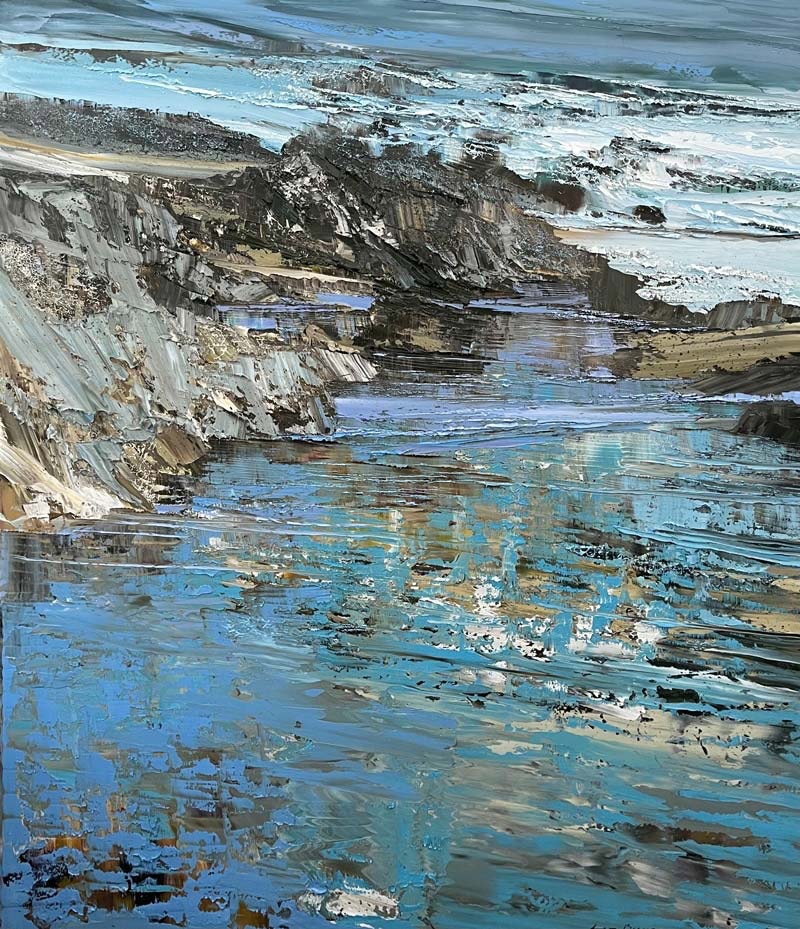 Lynn Boggess painted the sea and its myriad colors on 20 July 2023. He says, “I want everything in a painting–full color, full texture, depth and space. It’s too darn easy to make paintings that are one thing.” In this painting there is not only the texture of the rocks but also the texture of the surface of the water as it flows and folds on itself, reflecting the stones and the sky. As light reflects off it and through it, the blue sea reveals itself to be more than that.
Lynn Boggess painted the sea and its myriad colors on 20 July 2023. He says, “I want everything in a painting–full color, full texture, depth and space. It’s too darn easy to make paintings that are one thing.” In this painting there is not only the texture of the rocks but also the texture of the surface of the water as it flows and folds on itself, reflecting the stones and the sky. As light reflects off it and through it, the blue sea reveals itself to be more than that.
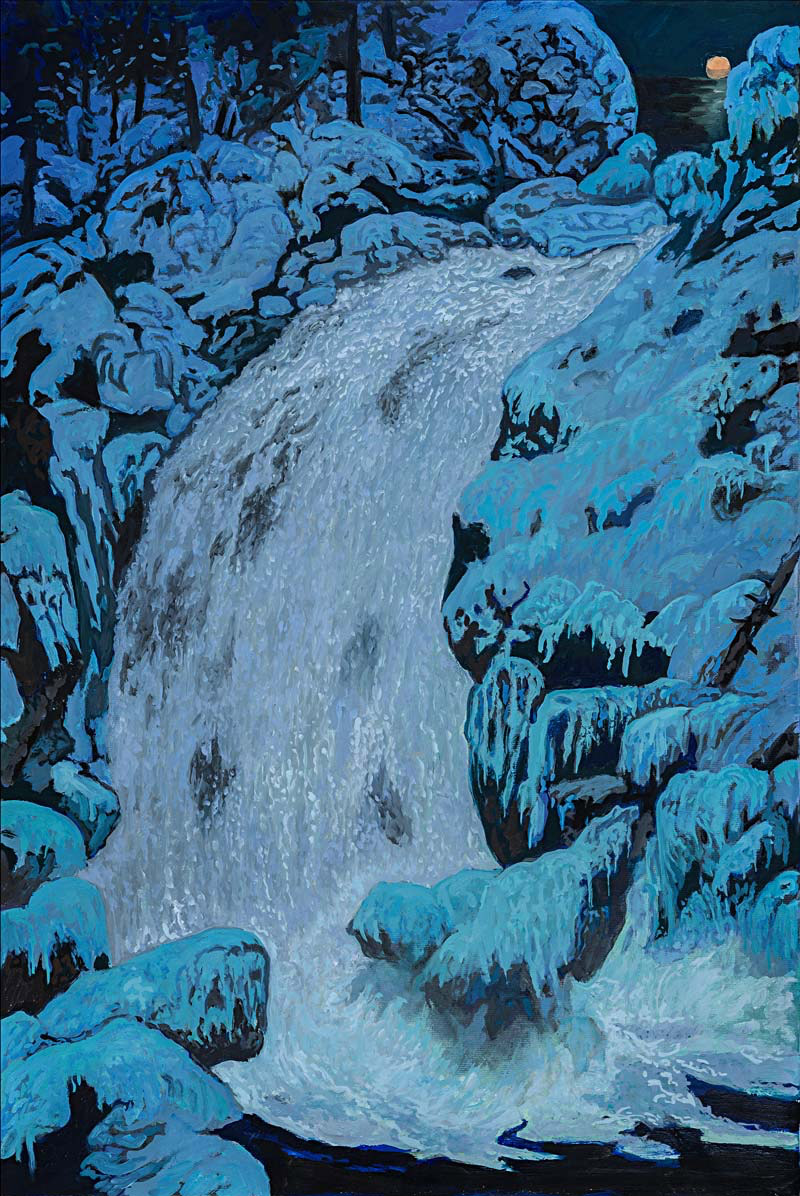 Michael Scott lives in an area south of Santa Fe free of light pollution, where he can step out of his home or his studio and see the expanse of the Milky Way spread across the sky. One of his painter heroes is the 19th century German romantic painter Caspar David Friedrich, who wrote,
“The artist should not only paint what he sees before him, but also what he sees within him.”
Michael Scott lives in an area south of Santa Fe free of light pollution, where he can step out of his home or his studio and see the expanse of the Milky Way spread across the sky. One of his painter heroes is the 19th century German romantic painter Caspar David Friedrich, who wrote,
“The artist should not only paint what he sees before him, but also what he sees within him.”
Michael’s next exhibition at Evoke is titled Habitat and the Preternatural, that miraculous state that is inexplicable by ordinary means. In his painting Moon Over Fire Hole, the fluid river falls over the solid rock of Yellowstone, but the two become one in the blue light. The moon appears almost incidentally with its reflected warm light.
I first experienced the phenomenon of blue “moonlight” at Prajna Mountain Forest Refuge north of Santa Fe on a Zen retreat with Roshi Joan Halifax. In the middle of the night I heard a noise and unzipped the flap of my tent to be greeted not by a hungry bear but by a world of luminous blue. Even when confronted with the miraculous, I am cursed to discover “Why?”.
The rods and cones in the eye turn light into electrical signals that the brain interprets as sight. The 19th century Bohemian physiologist Jan Evangelista Purkyně discovered that the light sensitivity of the eyes shifts to the blue end of the spectrum in low light conditions. My brain interpreted the message being sent to it as “blue light”.
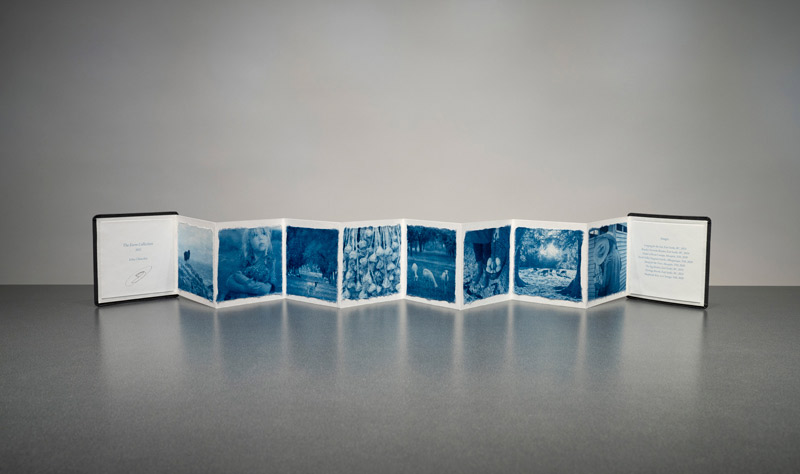 In the gallery’s current exhibition, Lettera Amorosa, Esha Chiocchio has created a fan fold book of cyanotypes, a camera-less process of exposing light-sensitive paper to UV light and washing with water. The result is Prussian Blue images. There is a “why” or “how”. Paper or fabric is coated with a mixture of ferric ammonium citrate and potassium ferricyanide. The oxidation of potassium ferricyanide produces Prussian Blue.
In the gallery’s current exhibition, Lettera Amorosa, Esha Chiocchio has created a fan fold book of cyanotypes, a camera-less process of exposing light-sensitive paper to UV light and washing with water. The result is Prussian Blue images. There is a “why” or “how”. Paper or fabric is coated with a mixture of ferric ammonium citrate and potassium ferricyanide. The oxidation of potassium ferricyanide produces Prussian Blue.
The images in each of her two books are The Nature Collection and The Farm Collection reflecting her “deep love for the natural world and for the pastoral life most humans experienced before industrialization.” She has been photographing farms and regenerative architecture and enlarged the negatives to make her contact-printed cyanotypes.
On a recent artist residency in Chile, Esha did a lot of night photography and pondered how she could print cyanotypes on thin enough paper to be backed with silver, so the stars would be luminous. She is continuing to explore the possibilities and, meanwhile, printed these images on earthy, rough-edged Kozo mulberry paper from Japan.
When “Looking and Seeing”, there are many “aha” moments. Looking at Esha’s cyanotype Longing for the Sea, East Sooke, BC, Canada, I thought immediately of Caspar David Friedrich’s painting Wanderer above the sea of fog, ca. 1817.
I’ll just leave that moment here.
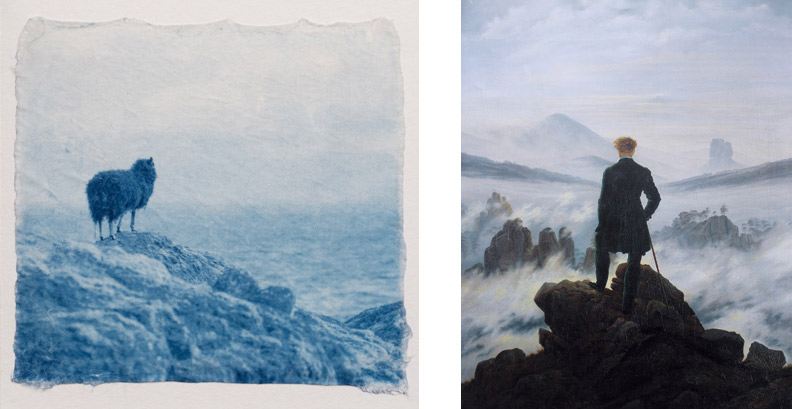 Above left: Esha Chiocchio, Longing for the Sea, East Sooke, BC, Canada, cyanotype, 6" x 6".
Above right: Caspar David Friedrich, Wanderer above the sea of fog, c.1817, Hamburger Kunsthalle, Hamburg, Germany.
Above left: Esha Chiocchio, Longing for the Sea, East Sooke, BC, Canada, cyanotype, 6" x 6".
Above right: Caspar David Friedrich, Wanderer above the sea of fog, c.1817, Hamburger Kunsthalle, Hamburg, Germany.



